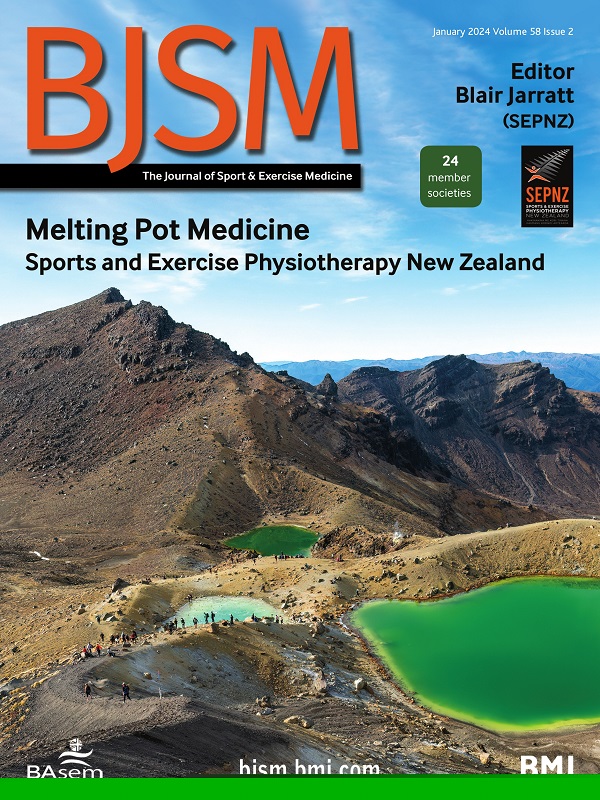Effects of different aerobic high-intensity interval training prescription approaches on cardiorespiratory fitness and performance in distance runners (PhD Academy Award)
IF 16.2
1区 医学
Q1 SPORT SCIENCES
引用次数: 0
Abstract
The aim of my PhD was to investigate how different approaches to prescribing aerobic high-intensity interval training (HIIT) influence cardiorespiratory fitness and performance in distance runners. Specifically, I compared three methods: a physiological approach (PHY), which individualises intensity using the Delta concept, based on the second lactate threshold (vLT2) and peak treadmill speed (Vpeak); a race pace-based approach (RACE), which sets intensity relative to target (10 000 m) race speed; and a standardised ‘one-size-fits-all’ approach (STD), in which all runners followed the same group-based training protocol, irrespective of individual physiological characteristics. The comparisons PHY versus RACE and PHY versus STD were treated as distinct research questions. This project sought to determine whether laboratory-based, physiologically individualised HIIT prescriptions are more effective at improving cardiorespiratory fitness than more commonly used, less individualised approaches. Moreover, I investigated whether prescribing HIIT based on race pace optimises performance compared with physiological prescriptions. Finally, I explored the variability in Vpeak and 10 000 m speed at vΔ50 (the speed midway between vLT2 and Vpeak) to assess whether these could serve as simpler alternatives to the Delta concept for individualising HIIT. The rationale for my PhD is illustrated in figure 1. Outside the experimental part of my PhD, I also reviewed the use of equivalence and non-inferiority designs to complement or replace traditional null hypothesis testing, aiming to …不同有氧高强度间歇训练处方方式对长跑运动员心肺功能和表现的影响(博士学院奖)
我博士学位的目的是研究不同的有氧高强度间歇训练(HIIT)处方如何影响长跑运动员的心肺健康和表现。具体来说,我比较了三种方法:生理方法(PHY),基于第二乳酸阈值(vLT2)和跑步机峰值速度(Vpeak),使用Delta概念个性化强度;以比赛速度为基础的方法(race),即相对于目标(10000米)比赛速度设定强度;另一种是标准化的“一刀切”方法(STD),在这种方法中,所有跑步者都遵循相同的基于小组的训练方案,而不考虑个人的生理特征。PHY与RACE和PHY与STD的比较被视为不同的研究问题。该项目旨在确定以实验室为基础的、生理上个性化的HIIT处方是否比更常用的、不太个性化的方法更有效地改善心肺健康。此外,我调查了与生理处方相比,基于比赛配速的HIIT处方是否能优化性能。最后,我探索了Vpeak和10000米速度在vΔ50 (vLT2和Vpeak之间的速度)的可变性,以评估这些是否可以作为个性化HIIT的Delta概念的更简单的替代方案。我攻读博士学位的基本原理如图1所示。在我博士学位的实验部分之外,我还回顾了等效性和非劣效性设计的使用,以补充或取代传统的零假设检验,旨在…
本文章由计算机程序翻译,如有差异,请以英文原文为准。
求助全文
约1分钟内获得全文
求助全文
来源期刊
CiteScore
27.10
自引率
4.90%
发文量
217
审稿时长
3-8 weeks
期刊介绍:
The British Journal of Sports Medicine (BJSM) is a dynamic platform that presents groundbreaking research, thought-provoking reviews, and meaningful discussions on sport and exercise medicine. Our focus encompasses various clinically-relevant aspects such as physiotherapy, physical therapy, and rehabilitation. With an aim to foster innovation, education, and knowledge translation, we strive to bridge the gap between research and practical implementation in the field. Our multi-media approach, including web, print, video, and audio resources, along with our active presence on social media, connects a global community of healthcare professionals dedicated to treating active individuals.

 求助内容:
求助内容: 应助结果提醒方式:
应助结果提醒方式:


